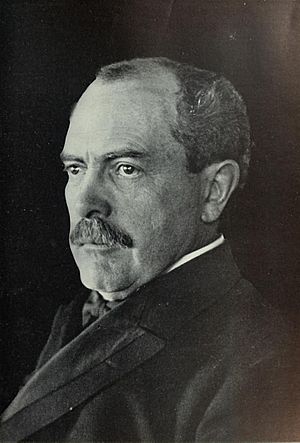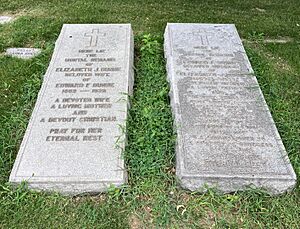Edward Fitzsimmons Dunne facts for kids
Quick facts for kids
Edward Fitzsimmons Dunne
|
|
|---|---|
 |
|
| 24th Governor of Illinois | |
| In office February 3, 1913 – January 8, 1917 |
|
| Lieutenant | Barratt O'Hara |
| Preceded by | Charles S. Deneen |
| Succeeded by | Frank Orren Lowden |
| 38th Mayor of Chicago | |
| In office April 10, 1905 – April 15, 1907 |
|
| Preceded by | Carter Harrison, Jr. |
| Succeeded by | Fred A. Busse |
| Personal details | |
| Born | October 12, 1853 Watertown, Connecticut, US |
| Died | May 24, 1937 (aged 83) Chicago, Illinois, US |
| Resting place | Calvary Cemetery |
| Political party | Democratic |
| Spouse |
Elizabeth J. Kelly
(m. 1881; died 1928) |
| Profession | Lawyer, Judge, Politician |
Edward Fitzsimmons Dunne (born October 12, 1853 – died May 24, 1937) was an American politician. He served as the 24th Governor of Illinois from 1913 to 1917. Before that, he was the 38th mayor of Chicago from 1905 to 1907. Edward Dunne is the only person ever elected as both Mayor of Chicago and Governor of Illinois.
Contents
Early Life and Family
Edward Dunne was born in 1853 in Watertown, Connecticut. His father, Patrick William Dunne, was a strong supporter of Irish independence. He moved to America in 1849. Edward's mother, Delia Mary Lawlor, came from a family that helped build docks in Galway, Ireland.
In 1855, when Edward was a baby, his family moved to Peoria, Illinois. He went to public schools there. His father was a successful businessman. He was also active in both Irish and American politics. He helped raise money for Irish causes. He also hosted many Irish leaders at their home in Chicago. P. W. Dunne served on the Peoria City Council. He was also elected to the Illinois House of Representatives.
Education and Early Career
After high school in Peoria in 1871, Edward went to Trinity College in Dublin, Ireland. His father wanted him to study where famous Irish patriots had gone. A well-known writer, Oscar Wilde, was one of his classmates. Edward did very well at Trinity. However, he had to leave before graduating because his father faced money problems.
Edward returned to Illinois. He finished his education at Union College of Law in Chicago. He graduated in 1878. On August 16, 1881, he married Elizabeth F. Kelly. They had thirteen children, and nine of them lived to adulthood. After getting married, Edward started a successful law practice.
Becoming a Judge
In 1892, at 28 years old, Edward Dunne was elected a judge. He served on the Circuit Court in Chicago from 1892 to 1905. During his time as a judge, he also helped start the Irish Fellowship Club of Chicago. He became its first president in 1901.
Mayor of Chicago
In January 1905, Dunne left his judgeship to run for mayor of Chicago. He won the election on April 4, 1905. He beat his opponent, John Maynard Harlan. People who wanted reforms were very excited about his win. He officially became mayor on April 10, 1905.
As mayor, Dunne focused on a big issue: the city's streetcar system. He strongly believed the city should own the streetcar lines. He appointed Clarence Darrow and later Walter L. Fisher to help him with this goal. Dunne also helped lower the price of gasoline and water in Chicago. He was a big supporter of the city owning public services.
In 1907, Dunne ran for mayor again but lost to Fred A. Busse. Years later, in a survey of Chicago politics experts, Dunne was ranked as one of the city's top ten mayors.
After Being Mayor
After his time as mayor ended in 1907, Dunne went back to working as a lawyer. He tried to run for mayor again in 1911 but lost in the primary election.
Governor of Illinois
On January 17, 1912, Dunne announced he would run for Governor of Illinois. He won the Democratic Party primary election. In the main election, he defeated the current governor, Charles S. Deneen. Dunne and other Democrats benefited because the Republican Party was divided at the time.
He became Governor of Illinois on February 3, 1913. His family moved to the Illinois Governor's Mansion in Springfield, Illinois. Many important people visited him there, including former U.S. President Theodore "Teddy" Roosevelt.
As governor, Dunne supported many important changes. These included:
- Giving women the right to vote.
- Making improvements to prisons.
- Upgrading the state's roads and bridges.
- Creating new commissions for public services and government efficiency.
- Expanding benefits for workers and pensions for teachers.
In 1913, Governor Dunne signed a law giving women in Illinois the right to vote for President. Illinois was the first state east of the Mississippi River to do this. This happened six years before the 19th Amendment gave all women in the U.S. the right to vote.
In 1915, Governor Dunne sent a representative to travel with the Liberty Bell. The bell was on a nationwide tour. It passed through southern Illinois on its way back to Pennsylvania.
Later Life and Legacy
After his term as governor ended in 1917, Dunne stayed involved in politics. In 1921, he helped start an organization to fight against the Ku Klux Klan.
In 1919, Dunne traveled to the Paris Peace Conference in France. He was part of a group that wanted an independent Ireland. He also visited Ireland and met with Irish politicians.
Dunne continued his law practice after leaving office. He also worked as a lawyer for the Cook County Board of Election Commissioners. After his wife passed away in 1928, Dunne decided to write a history of Illinois. In 1933, he published a five-volume set called Illinois, the Heart of the Nation.
When he was 80 years old, President Franklin Roosevelt appointed Dunne as a U.S. Commissioner. This was for the Century of Progress World's Fair in Chicago (1933-34). He enjoyed this role and joked that he had served at all levels of government: mayor, governor, and federal commissioner.
Death
In his later years, Edward F. Dunne lived with his oldest daughter, Eileen. He passed away in Chicago on May 24, 1937, at 83 years old. He is buried next to his wife Elizabeth at Calvary Cemetery in Evanston.
See also
- Chicago Traction Wars



